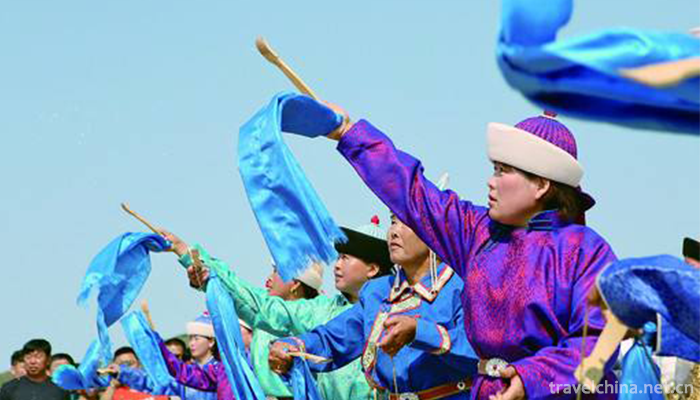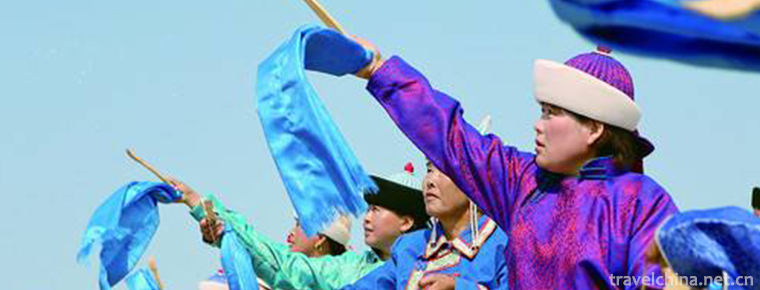Bogda Ula Festival
Bogda Ula Festival
The sacrifice of Bogdahura (Shenshan) is one of the earliest forms of Mongolian creative culture in China. It is the product of national culture, which is formed by historical accumulation and pluralism. It studies the special system of Mongolian folklore in a comprehensive and multidisciplinary way. The basic judgment is that sacrificial activities prevailed in Zalaite Banner during Tang, Song and Yuan Dynasties, especially after Shamanism was introduced into other places, and integrated with local customs to form a historical national cultural achievement. Although historical records are not fully recorded, historians believe that Zalai Banner was a historical national cultural achievement. The sacrifice to the God hill of Laite is another monument of Chinese folk culture. It can be seen from the origin of the sacrificial form of mountain names, the statues of God hills, the scriptures of God hills, the carols of God hills, the matching Nadamu congress, economic and trade exchanges and other relics. What a magnificent sacrifice to Bogdahura (god hill) was at that time! Its comprehensive Mongolian culture has a clear skeleton and a long history of inheritance. The sacrificial activities of Bogdahura (Shenshan) created by the Mongolian people have passed down from generation to generation in Zalaite, and become more and more solemn. The more formal the theme, the more three-dimensional development. However, because the sacrifice of Shenshan has been spread and presided over in Mongolian, there is no chance to translate into Chinese and English, so it has a serious closed impact at home and abroad. By the late 1950s, scholars and famous literary figures in Inner Mongolia, such as Jinfeng, Liu Yingman, Zhou Juxia and Liu Shaohua, publicly published the sacrifice of Shenshan in books and periodicals. In the 1960s, it aroused the attention of the leaders of Inner Mongolia Autonomous Region and people with lofty ideals from all walks of life. When Chairman Buch visited, he also came to Zalaite to mention the sacrifice of Shenshan, which aroused the attention of Comrade Bao Junchen, Vice-Chairman of the Political Consultative Conference of Inner Mongolia Autonomous Region. After that, the major TV stations recorded and broadcast the contents and procedures of the sacrifice of Shenshan from different perspectives, forming documentary prose and academic papers. Relevant materials such as "Environmental Protection Textbook" of Fang Party Course. A set of books and magazines on Bogda Ula (Shenshan) sacrificial culture will be published to recommend sacrificial activities, which will cause scholars at home and abroad to discuss Bogda Ula (Shenshan) sacrifice as a result of Mongolian and Yuan culture, and write a historical chapter with their own characteristics.
Zalaite Bogdahura (Shenshan) sacrifice has a long history, unique form, content and scriptures of Shenshan, and there are absolutely no mountain gods. In sacrificial activities, the time, place and preparation of sacrificial offerings are notified by the Yamen, and sacrificial offerings are held. The Lord sings the song "Ode to Ketuura in Uliji Chao" in Mongolian, invites the living Buddha to recite sutras, and then holds the Nadamu congress, trade material exchange and performing traditional Mongolian songs and dances, which are matched with the sacrificial offerings. It is said that the sacrifice of Bogdahura (Shenshan) is held from May 21 to May 23 of the lunar calendar every year, and the sacrificial activities are solemn and unique. Location: Bogda Ura Heimaurihada (Shenshan). 1. Pre-sacrificial preparation: First, the Qiyamen Damule (presided over) announces the date and place of sacrifice, accepts incense, food, wine and other personal apportionment items from each Nutuk; the task of Harule is to make a seven-day tour of the mountains, punished by hunters and fellers. 2. Scale: Each Nutuk arrives one day ahead of the sacrificial time and gathers at the south foot of Shenshan Mountain. In the center is the Mongolian yurt group of Qiwang Ye and his family, on the right is the Mongolian yurt group of Yamen officials and living Buddhas, doctors and businessmen, and on the left is the Mongolian yurt group of grass-roots officials and ordinary people in Konutuk. 3. Procedures, sacrificial offerings and other preparations: regularly carry Lama's drums, trumpets and other magic instruments and sacrificial offerings such as sheep and wine to designated sacrificial sites in Shenshan. 4. Decoration of Obo: Damuler's will, with decorations, began to decorate Obo in Black Maurihada, hanging picking banners or cloth strips around Obo, placing yellow cloth on a large strip of slate, placing dozens of bowls filled with water, wine and offerings, placing the rear feet of sheep and cattle, etc. In the south side of Obo, a white Jade statue of the Han Dynasty and several large-character banners of "Mountain God Sacrifice" were erected. 。 5. Lamas chant scriptures: In the past, the main character of Aobao was Lamas. After all the offerings were put on display, dozens of lamas sat in front of Aobao with cockcrown caps and robes. They recited the scriptures of God. When the big lamas waved Ling in their hands and lifted the macaroni in their other hands, bronze trumpets rang through the valley. 6. Pointing to the mountain gods: After the Lama recited the sutras, the Lord Master Mahbatu of Zazakh Belle took the lead in kneeling to Obo, and Master Ruben gave the pilgrims a motto ceremony, and waited for Adis to be accepted. 7. Giving Adis: Han means food cleansed by mana through Buddhist sutras. Several etiquette officers sprinkled manna around Obo. It was said that eating the Adis would bring good luck. 8. Convening the Obo Conference: The people who attended the sacrifices came down from the mountains and returned to the Mongolian yurts, and then began the Obo Conference. Presided over by Prince Marenshbatu of Zazakhstan, this paper mainly discussed the topic of how to protect the ecological environment of Shenshan and how to protect the sacrificial activities of Bogdahura (Shenshan). Punishment for deforestation of hunters. 9. Entertainment banquet: Damule and Harule add wine and meat to everyone. People sing and dance. Lamas perform Chama dances. Everyone sings the song "Ode to Uliji Chao Ketuura". The atmosphere was very warm and high. 10. Nadamu: It is the Mongolian horse racing, archery and wrestling matched with the sacrificial activities. 11. Bogdahura (Shenshan) sacrifice brings in traders from inside and outside the banner for trade exchanges, such as sheepskin, fungus, local products, cattle, sheep and other trading activities. To sum up, year after year, the inheritance and development of Mongolian cultural system, in addition to its own characteristics, promote national unity and improve the quality of the development of Zalaite harmonious society.


-
1.Cocotto Sea Scenic Area
The Cocotto Sea Scenic Area and Xinjiang Cocotto Sea National Geological Park, located in Fuyun County, Altay District, northern Xinjiang, covers an area of 788 square kilometers,
Time 2018-12-12 -
2.Shanghai Fangta Garden
Fangta Garden is one of the gardens in the ancient city of Songjiang, which is mainly composed of historical relics. The garden covers an area of 182 mu. The site was originally the downtown center of
Time 2018-12-19 -
3.Ordos Cultural Tourism Village
Ordos Cultural Tourism Village is located in the front banner of Etok, Ordos City. It is located in the western Ordos grassland at the junction of Mengning and Ningxia. It is located in the beautiful
Time 2019-01-08 -
4.Chinese character calligraphy
Chinese character calligraphy has been recognized by the world for its brilliant civilization of 5000 years and its incomparable rich written records. In this vast and profound history,
Time 2019-05-02 -
5.Sichuan ballad singing
Sichuan Qingyin, formerly known as Pipa and Yueqin, is one of the traditional operas in Sichuan Province. In the 1930s, Qingyin Song Concerts or Improvement Meetings were set up in Chengdu and Chongqi
Time 2019-06-16 -
6.Sichuan Tourism University
Sichuan Tourism College is the first independent tourism undergraduate college in China. In 2018, it was approved by the Overseas Chinese Office of the State Council as the base of "Overseas Chin
Time 2019-08-31 -
7.Han Feizi
Han Feizi is a collection of works of famous thinkers and Legalists Han Fei during the Warring States period. Han Feizi was compiled by posterity after Han Fei's death. According to hanshuyiwenzhi &qu
Time 2019-09-07 -
8.Hanging coffin of Bo people BoRen
"Bo People's hanging coffin" is located in Yibin City, Sichuan Province. It is distributed in Gongxian County, Xingwen County and Junlian county. "Gong county annals" records that "Gongben Bo land, Bo people hanging coffins.".
Time 2020-10-16 -
9.Can Ding Zhens Pony pearl really run first
Recently, after the exposure of Ding Zhen's Pony pearl, many netizens have a question in their hearts: "can it really run first?"? After the news release, netizens have been hotly debated. The specific contents are as follows:
Time 2020-12-07 -
10.Nanchong first industry
In 2019, the sown area of grain crops in Nanchong is 558000 ha, which is 0.15% lower than that in 2018. The sown area of oil crops is 152000 ha, an increase of 1.9% over that in 2018. The vegetable planting area is 154000 hectares, an increase of 3.9% over that in 2018.
Time 2020-12-17 -
11.Animal resources in Meishan
There are many species of wild animals in Meishan City, and the floristic composition is more complex, mainly subtropical forest animals. There are 469 species of terrestrial wild (vertebrate) animals, including 91 species of mammals, 18 orders, 27 families, 65 genera,
Time 2020-12-18 -
12.Yibin transportation
Yibin is a transportation hub city in South Sichuan, which is famous for its comprehensive three-dimensional transportation network of water, land and air. It is located at the starting point of the golden waterway of the Yangtze River and the strategic point of Sichuan Yunna
Time 2020-12-18